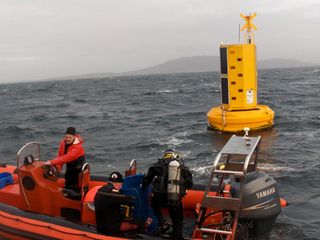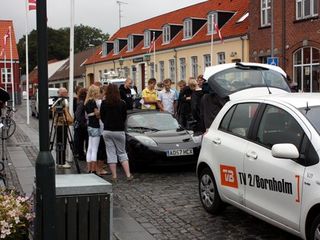8 unexpectedly amazing tech projects from IBM
How IBM's stuck its fingers into everything from Mars bars to electric cars

Innovation is often the result of intense research by brainiac scientists with multiple higher-ed degrees.
At IBM Research, there are eight labs over over the world, including one in Israel and three in the US.
Yet, the most interesting projects are taking place "in the field" where the 100-year-old company is analyzing river deposits, speeding up financial transactions, and figuring out how to manage wind power usage.
These projects are excellent examples of how computer technology is intersecting with the physical world, instead of just bits and bytes on a computer screen somewhere, stuffed away in a dark lab.
"Data is exploding all over the planet, so we are finding new ways for IT systems to be more physical," says Robert Morris, the VP of Services Research at IBM. "There is so much data being derived from many different means, such as physical sensors, and there are new intriguing ways to put them all together. There is a new technology needed – what is called perpetual analytics – looking for new trends and making decisions."
1. TD Bank stock market analysis
The stock markets are fluctuating faster than any analyst could possibly comprehend. Yet, these real-time changes are difficult even for modern computers to analyse. IBM is working with TD Bank in Toronto to analyse data using "stream computing" techniques that consist of complex algorithms. These can read data on-the-fly and help analysts make decisions about the data, even as the inputs change.
"We are researching the ability to process data from a huge number of sources, so this project is using stream computing and the Blue Gene supercomputer," says Morris. "We are able to get a 21x speed-up than any other system. The messages and sensors in the financial systems are increasing at more than 50 per cent each year – faster than doubling every two years – so something new is needed to analyse this data."
Get daily insight, inspiration and deals in your inbox
Get the hottest deals available in your inbox plus news, reviews, opinion, analysis and more from the TechRadar team.
"The goal of any automated trading system is to reduce the time between the receipt of market data messages and the decision, achieving a very low latency while processing extreme amounts of data," adds Nagui Halim, chief scientist of the Stream Computing Project at IBM.
"The more messages a system can process, the more decisions can be made, hence, the more valuable the system. In order to achieve the breakthrough, the IBM team took one minute of recorded financial exchange data from the TD Bank network and played it back into the newly developed Stream-Blue Gene system, incrementally increasing the speed at which the data was sent."
2. Beacon Institute/Hudson River data project
One of the challenges researchers face when analyzing real-time data is that the storage requirements increase dramatically. For example, one research lab might support a petabyte of data storage for all experiments, but a project analyzing real-time data from sensors might capture a petabyte of data every minute.
With the The Beacon Institute in New York, IBM is analysing the Hudson River using thousands of sensors that monitor river flow, wind conditions, and temperatures.

The project is unique in that this kind of research usually replies on historical data to build plume models (how a toxin in a river will spread, for example), but the IBM system reads the data, merges it into data sets, and then allows researchers to make decisions about the river.
"We're detecting anomalies in the river system with thousands of sensors that can monitor an accidental spill or a toxic flow," says Morris. "It is critical to detect that the fluid is spreading and now toxic – it's very important to put it in context. We believe that is the future of data analysis."
3. Mars and cocoa genome sequencing
The Mars bar and genome sequencing are usually not uttered in the same sentence. Yet, IBM Research – along with Mars and the United States Department of Agriculture – is developing a genetic map of the cocoa genome.
The goal of the project is to learn more about cocoa as a way to assist farmers in planting cocoa in Africa, where 70 per cent of the cocoa used in candy bars is produced. The idea is to yield more from each cocoa plant and then have a lesser impact on the environment in the region. The research will be released to the public for aiding in cocoa farming around the world. The project will take about five years and involves computational biology and genetic mapping at both the IBM Research facility in New York at at the USDA.
4. EDISON electric car project
In the city of the future, electric cars will will finally become a reality – especially if start-ups such as Tesla Motors become successful. Yet, the computational dilemma is that, if everyone is driving electric cars, we will consume too much power and force coal plants to work over-time.
The EDISON project, a joint effort between IBM and the largest energy utility in Denmark, plus several key partners, are developing a way to link wind-power energy generation with electric car power usage over a smart grid. (EDISON stands for Electric Vehicles in a Distributed and Integrated Market using Sustainable Energy and Open Networks.) The pilot will take place on an island in Denmark that is unique in that wind power is a primary part of the power infrastructure for the 40,000 residents.

The project is important because electric cars and hybrid consume energy at varying levels, so the smart grid will monitor usage in real-time and help allocate energy from the wind stations. "It's necessary to think holistically about electric vehicles and how they are connected with sustainable energy," says Morris.
- 1
- 2
Current page: River flow, Mars bars and electric cars
Next Page Transport, health and surveillanceJohn Brandon has covered gadgets and cars for the past 12 years having published over 12,000 articles and tested nearly 8,000 products. He's nothing if not prolific. Before starting his writing career, he led an Information Design practice at a large consumer electronics retailer in the US. His hobbies include deep sea exploration, complaining about the weather, and engineering a vast multiverse conspiracy.

